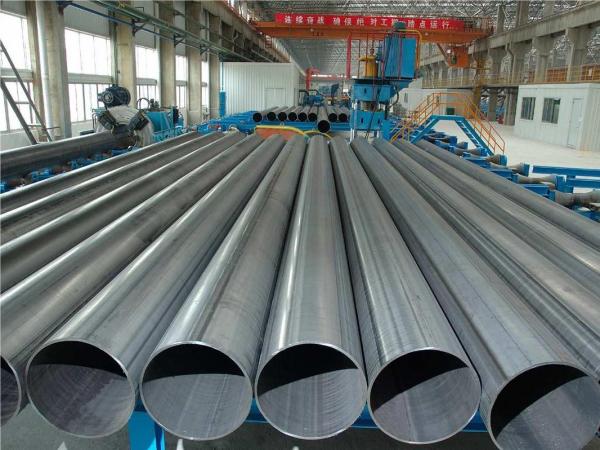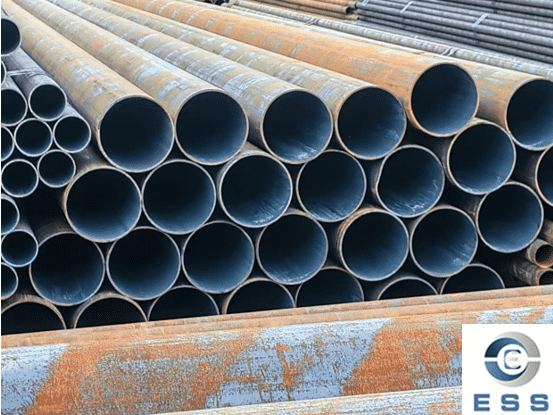1.Introduction
Electric Resistance Welded tubes, also known as electric resistance welded pipes, are widely used in numerous industries due to their unique combination of properties. ERW tubes are created through a welding process that utilizes electrical resistance to produce a strong and seamless bond between the metal sheets. This article explores the properties of ERW tubes, including their manufacturing process, advantages, limitations, and various applications.

2.Manufacturing Process of ERW Tubes
The manufacturing process of ERW tubes involves several steps. Initially, flat steel strips are uncoiled and passed through a series of rollers to form a continuous coil. The edges of the coil are then prepared for welding through processes like trimming, skiving, or scarfing. The edges are subsequently heated using high-frequency induction or contact welding methods. Pressure is applied to fuse the edges together, forming a welded joint. After welding, the excess material is removed, and the tube is further processed through sizing, straightening, and cutting operations.
3.Advantages of ERW Tubes
ERW tubes offer numerous advantages, making them a popular choice in various applications. Some of the key advantages include:
Cost-effectiveness: ERW tubes are relatively inexpensive compared to other types of tubes.
High production efficiency: The manufacturing process of ERW tubes is fast and efficient, allowing for large-scale production.
Excellent dimensional control: ERW tubes offer precise and consistent dimensions, ensuring better fit and compatibility in applications.
Good weld integrity: The welding process in ERW tubes results in a strong and reliable joint.
Wide range of sizes and thicknesses: ERW tubes are available in various sizes and thicknesses, offering versatility in design and application.
4.Limitations of ERW Tubes
Despite their many advantages, ERW tubes also have some limitations that should be considered in specific applications. These limitations include:
Lack of suitability for high-pressure applications: ERW tubes may not be suitable for applications that require resistance to high internal pressures or corrosive environments.
Limited shape options: ERW tubes are primarily available in round or square shapes, which may restrict their use in certain designs.
Potential for welding defects: Improper welding conditions or material inconsistencies can result in welding defects such as porosity or incomplete fusion.
5.Mechanical Properties of ERW Tubes
ERW tubes exhibit favorable mechanical properties, which contribute to their widespread use. The key mechanical properties include:
5.1. Tensile Strength: ERW tubes typically possess high tensile strength, enabling them to withstand applied loads without deformation.
5.2. Yield Strength: ERW tubes offer a satisfactory yield strength, indicating their ability to resist permanent deformation under stress.
5.3. Ductility: ERW tubes exhibit good ductility, allowing them to undergo plastic deformation without fracturing.
5.4. Hardness: ERW tubes generally possess desirable hardness properties, ensuring resistance to wear and abrasion.
5.5. Impact Resistance: ERW tubes demonstrate excellent impact resistance, making them suitable for applications subjected to dynamic loading.
6.Microstructural Properties of ERW Tubes
The microstructural properties of ERW tubes are influenced by the welding process and material composition. Key microstructural features include:
6.1. Grain Structure: The grain structure of ERW tubes is typically refined due to the heating and cooling during the welding process, resulting in improved mechanical properties.
6.2. Weld Zone: The weld zone in ERW tubes consists of a fusion line and heat-affected zone (HAZ). The fusion line exhibits a distinct microstructure due to the localized melting and solidification during welding.
6.3. Heat-Affected Zone: The HAZ adjacent to the fusion line experiences varying degrees of temperature change, resulting in altered microstructure and mechanical properties.
6.4. Base Metal: The base metal of ERW tubes retains its original microstructure, providing consistent properties throughout the tube.
7.Applications of ERW Tubes
ERW tubes find extensive applications in various industries, including:
7.1. Structural Applications: ERW tubes are commonly used in the construction of buildings, bridges, and infrastructure due to their excellent strength-to-weight ratio.
7.2. Automotive Industry: ERW tubes are utilized in the manufacturing of chassis, roll cages, exhaust systems, and other structural components in automobiles.
7.3. Construction Sector: ERW tubes are employed in scaffolding, fencing, handrails, and other structural elements in the construction industry.
7.4. Oil and Gas Industry: ERW tubes are used in pipelines, well casings, and other applications within the oil and gas sector due to their durability and resistance to corrosion.
7.5. HVAC Systems: ERW tubes find use in heating, ventilation, and air conditioning systems for their thermal conductivity and reliability.
7.6. Furniture Manufacturing: ERW tubes are utilized in the production of furniture frames, ensuring strength and stability.
8.Conclusion
Electric Resistance Welded (ERW) tubes possess a range of desirable properties, making them a versatile and cost-effective choice for numerous applications. Their manufacturing process, which involves electrical resistance welding, ensures strong and seamless joints. ERW tubes offer advantages such as cost-effectiveness, high production efficiency, and good weld integrity. While they may have limitations and specific considerations, their mechanical and microstructural properties enable their utilization in various industries, including construction, automotive, oil and gas, and HVAC. By understanding the properties of ERW tubes, engineers and designers can make informed decisions when selecting materials for their projects, optimizing performance and efficiency.













 Eastern Steel Manufacturing Co.,Ltd not only improve product production and sales services, but also provide additional value-added services. As long as you need, we can complete your specific needs together.
Eastern Steel Manufacturing Co.,Ltd not only improve product production and sales services, but also provide additional value-added services. As long as you need, we can complete your specific needs together.










